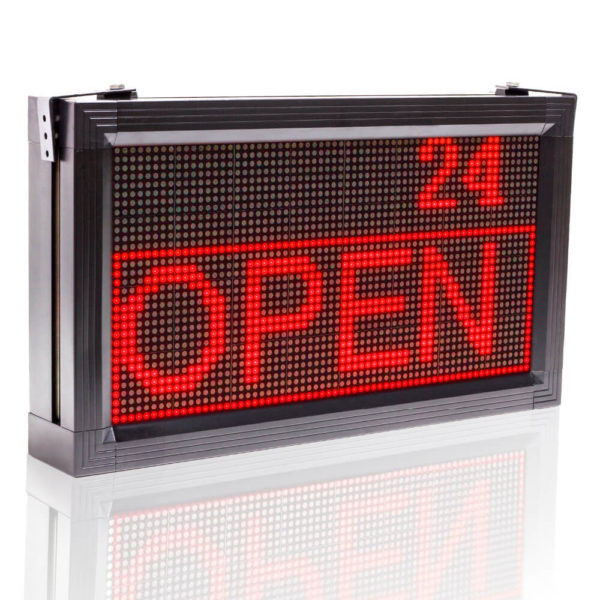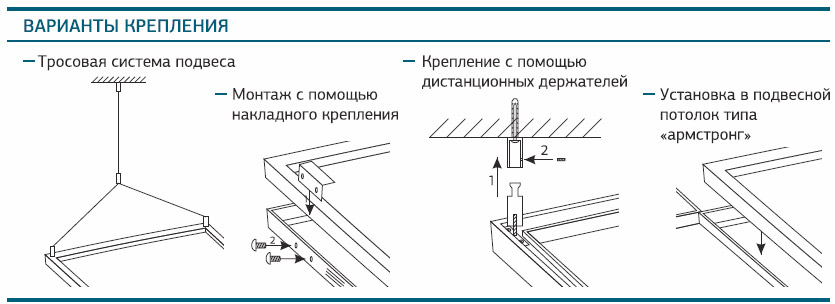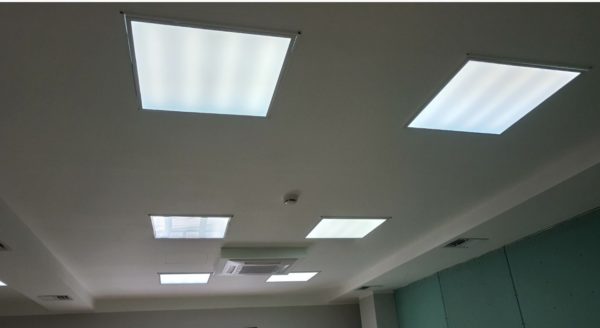Installation of LED panels
Replacing incandescent lamps with diode light sources is a matter of time. Modern repairs increasingly include the installation of LED panels. These are devices for lighting large areas, such as stores, train stations, entertainment complexes, as well as apartments and houses. The main advantage is the low power consumption.
If compared to other light sources, the panels have a greater luminous flux with similar power. Also important to the buyer is the service life. Diode devices last at least 10 times longer than other lights.
What you need to know when installing LED panels
The design of the product is usually the following: the body is made of aluminum with high thermal conductivity characteristics, for heat dissipation from the LED elements. If the chips overheat, it negatively affects the service life.
The internal diffuser is made of organic glass. It provides a soft light spreading over the entire panel. Another element of the design is a conductive lens which creates a matte diffusion. Due to it looking at the light eyes do not get tired, and people in the room can maintain attention and concentration.

LEDs are placed around the perimeter of the housing. Overheating rarely occurs. Behind the lens is a reflective film. It is needed to redistribute the light flux perpendicularly downwards.
Variety of LED panels
LED panels come in:
- rectangular;
- round;
- square.

The size can be ordered at your discretion. The average thickness is 1.4 cm. In rooms with low ceilings, it is advisable to install panels, as they can visually raise it due to the scattering matte glow. Thin devices, regardless of power and color, can be easily fixed in a suspended or overhead position. They can also be combined with spotlights.
The design of almost all panels is the same, only the configuration changes. According to the purpose of the products can be ceiling and advertising (found on billboards of the night city).

They are made in the form of a display with diodes, which play the role of pixels on the monitor screen. Sometimes it is an integral background glow, creating a dynamic image that attracts the attention of potential customers. The effect is achieved by connecting each of the chips to a separate circuit.
Ceiling panels are actively replacing the market with fluorescent lamps, which were installed in offices. Now this option is not relevant. Indoors, where there are virtually no voltage fluctuations, diodes can last up to 20 years. When installed on the suspended ceiling look original, combining with the design of the room. You can adjust the intensity of the light.
See necessarily: Installation of LED panels on the concrete ceiling in a non-standard way, on magnets.
Panel mounts
LED panels can be installed on a variety of surfaces. There are several installation options:
- on a concrete surface;
- on suspended structures;
- On a suspended ceiling.
Each option has features that should be studied. LED products can be mounted on wood, but you should choose the right fasteners.
Installation on a concrete ceiling
The main fastening elements in this case are hangers, with which to adjust the height. They are usually included in the set. If they are not available, they can easily be purchased in the store. One of the important stages of installation - marking on the ceiling. It is necessary to be extremely accurate, otherwise the work will have to be redone.

In the process, the main thing is to fix the panel at the same level as the finishing material. To adjust the height, plastic or wooden pads are used. Fastening of hangers is carried out with self-tapping screws. Each hanger requires 3 self-tapping screws. Then the lamp is attached to the cable using the brackets welded at the corners. The cable should be passed through them, secured with a clamp.
You can buy steel fasteners in the form of corners. Install 4 pieces according to the markings on the ceiling, as well as on the corners of the panel, fasten with screws. The size of the corners chosen depending on the distance between the ceiling and the body of the lamp.
Installation on the plasterboard ceiling
LED panels are designed to fit into ceiling structures. The main requirement is to match the ceiling plane to the face of the fixture. If the ceiling slatted or panel ceiling, under the light should be allocated space and laid with the help of hangers.
Nothing needs to be cut out on the gypsum board ceiling. The best option is the installation technology on the base surface. In the process of laying, the fixing points are determined and metal profiles are placed under the luminaires as a base. After that, the luminaire is mounted in the same way as on concrete or corners.
Installation on a suspended ceiling
Installation of panels on the stretch ceiling on their own without experience is not recommended, because the technology is more complicated and depends on the materials of the ceiling surface. Here there are 2 options, the installation of recessed lighting or with the help of a cable.
If you choose a cable, draw a marking and mount a suspended ceiling, making 4 holes for the lamps. The next step is to install the cables to which the lighting fixture is attached.

If the first method is chosen, the base for the lamp must be installed on the level of the suspended ceiling from metal profile. The installed panel is immediately connected. The next step is to order the installation of the stretch ceiling, taking into account the presence of the lamp. If this is not possible, the light is attached to the surface with mounting brackets.
Peculiarities of the panel connection
The connection is determined by the driver. If it is in the case, its output terminals can be connected to the domestic electrical network. If it is missing, you will have to install it yourself. This can be done on the surface of the building structure or behind a suspended ceiling. After that, it is plugged into the LED lamp.
When choosing a driver, it is worth considering:
- input voltage;
- degree of protection. This will determine the location and mode of operation;
- output voltage;
- output current;
- power. The indicator determines the permissible load.
| Type of a room | Power of LED lights (watts per 10 m2) |
|---|---|
| Living room, bathroom | 30 |
| Bedroom, hallway, corridor | 20 |
| Kitchen | 40 |
| Children's room | 50 |
| Outer rooms | 10 |
When installing electrical wiring, you can use a wire with double insulation. The main cable with branches can power several luminaires at the same time. The main thing is to correctly calculate the power consumption.
Conclusion
LED panels are a modern variety of devices for lighting space. From other types of lights they differ in the area of luminous flux. One lamp can illuminate a large room. Installation should be carried out, relying on the ceiling material and shape.

